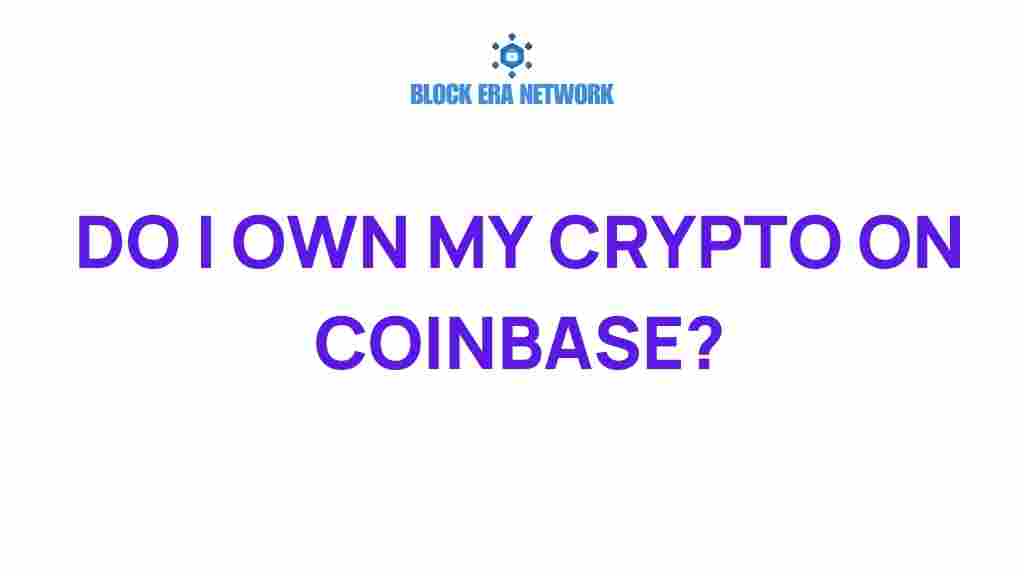Do You Truly Own Your Crypto on Coinbase? Unpacking the Myths and Realities
The rise of cryptocurrency has transformed the financial landscape, leading many to wonder about the true ownership of their digital assets. One of the most popular platforms for buying and trading cryptocurrency is Coinbase. But do you really own your crypto on Coinbase? In this article, we will explore the myths and realities surrounding cryptocurrency ownership, focusing on the nature of asset custody, user control, and the implications of using centralized exchanges like Coinbase.
Understanding Cryptocurrency Ownership
The concept of ownership in the cryptocurrency world can be quite different from traditional ownership of physical assets. When you buy cryptocurrency on a platform like Coinbase, you essentially hold a digital representation of that asset. However, true ownership hinges on your ability to control the private keys associated with those assets.
- Private Keys: These are cryptographic keys that enable you to access and manage your cryptocurrency. If you do not control your private keys, you do not truly own the cryptocurrency.
- Public Keys: These are derived from private keys and are used to receive funds. They can be shared with others without compromising your security.
Coinbase and Centralized Exchanges
Coinbase is a centralized exchange, meaning that it acts as an intermediary between buyers and sellers of cryptocurrency. While this makes it easy for new users to enter the crypto space, it also raises questions about user control and asset custody.
When you buy cryptocurrency on Coinbase, the platform manages your private keys on your behalf. This has both advantages and disadvantages:
- Advantages:
- Ease of use: Coinbase provides a user-friendly interface, making it accessible for beginners.
- Security: Coinbase implements robust security measures to protect user funds.
- Disadvantages:
- Limited control: You cannot directly access your private keys, meaning you rely on Coinbase for custody.
- Risk of hacks: Centralized exchanges are often targets for hackers, posing a risk to user funds.
Digital Assets and Asset Custody
Asset custody is a crucial aspect of cryptocurrency ownership. When using Coinbase, your digital assets are stored in the exchange’s wallets, which means that the platform is responsible for their security. Here’s what you need to know about asset custody:
- Custodial Wallets: Coinbase uses custodial wallets to hold users’ cryptocurrency. While this is convenient, it means that users do not have full control over their assets.
- Non-Custodial Wallets: For those who want full control over their digital assets, non-custodial wallets are the way to go. These wallets allow users to manage their private keys directly.
Blockchain Security and User Control
Blockchain technology offers a decentralized and secure method of storing and transferring digital assets. However, the security of your cryptocurrency largely depends on how you manage your private keys. Here are some key points to consider:
- Decentralization: Unlike traditional banking systems, blockchain operates on a decentralized network, reducing the risk of a single point of failure.
- User Control: If you use a non-custodial wallet, you have full control over your private keys, ensuring that you are the true owner of your crypto.
Step-by-Step: How to Secure Your Cryptocurrency
If you decide to use Coinbase for your cryptocurrency transactions but want to maintain a level of control over your assets, consider these steps:
- Create a Non-Custodial Wallet: Set up a wallet such as MetaMask or Ledger, which allows you to control your private keys.
- Buy Cryptocurrency on Coinbase: Use Coinbase to purchase your desired digital assets.
- Transfer to Your Wallet: Once you have purchased your cryptocurrency, transfer it from Coinbase to your non-custodial wallet.
- Secure Your Wallet: Ensure your wallet is secured with strong passwords, two-factor authentication, and backups.
Troubleshooting Tips for Coinbase Users
While using Coinbase is generally straightforward, you may encounter some common issues. Here are some troubleshooting tips:
- Transfer Delays: If your cryptocurrency transfer is delayed, check the transaction status on the blockchain explorer for confirmation.
- Access Issues: If you cannot access your account, ensure that you have entered the correct login details and reset your password if necessary.
- Security Alerts: Always pay attention to security alerts from Coinbase. If you receive unusual notifications, take immediate action to secure your account.
Conclusion: The Reality of Crypto Ownership on Coinbase
In conclusion, while Coinbase offers a convenient platform for buying and selling cryptocurrency, it is essential to understand the implications of using a centralized exchange. You do not truly own your crypto on Coinbase in the same way you would if you held your private keys in a non-custodial wallet.
The myths surrounding cryptocurrency ownership can lead to misunderstandings about user control and asset custody. By educating yourself and taking proactive steps to secure your digital assets, you can ensure that you have the level of ownership you desire. For more information about cryptocurrency ownership and security, you can check out this comprehensive guide on cryptocurrency wallets.
Whether you choose to keep your assets on Coinbase or transfer them to a non-custodial wallet, understanding the nature of cryptocurrency ownership is crucial in navigating the digital asset landscape.
As the world of cryptocurrency continues to evolve, staying informed about blockchain security, user control, and the risks associated with centralized exchanges will empower you to make the best decisions about your digital assets.
This article is in the category Cryptocurrency Insights and created by Block Era Network Team

1 thought on “Do You Truly Own Your Crypto on Coinbase? Unpacking the Myths and Realities”